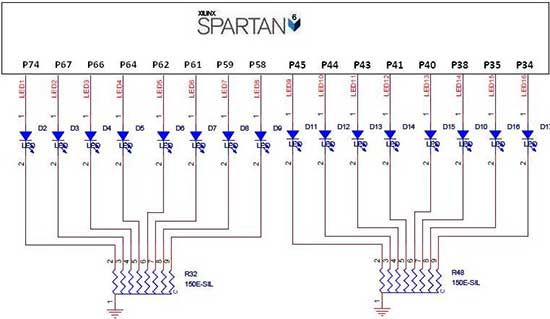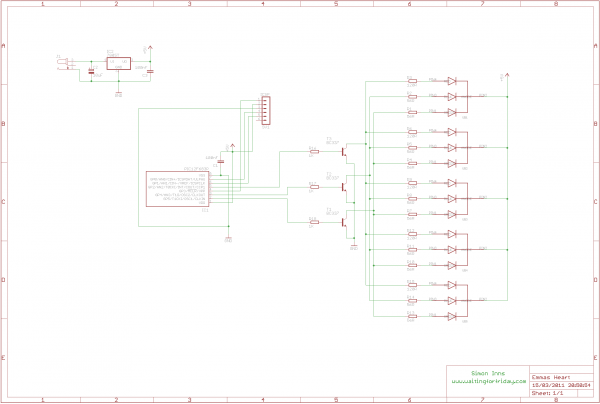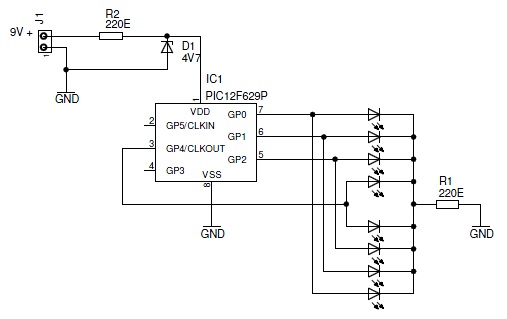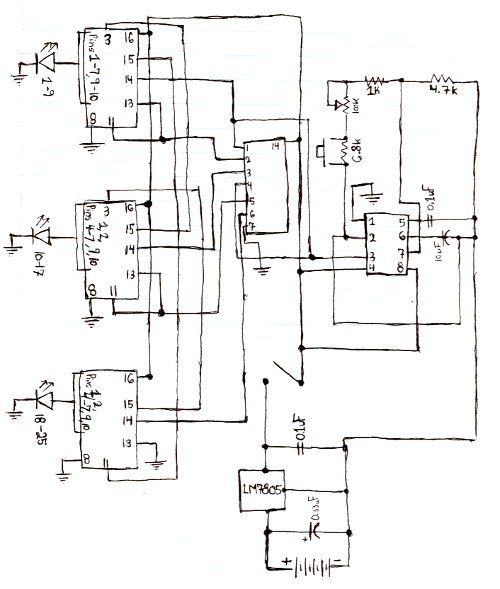
LED Knight RiderCircuit With 4017 and 555 IC
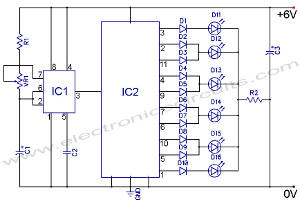
The following circuit illustrates an LED Knight Rider Circuit Diagram. This circuit is based on the 4017 and 555 integrated circuits. Features include the Knight Rider effect with four LEDs.
The LED Knight Rider circuit is designed to create a visual effect reminiscent of the iconic "Knight Rider" television series, where lights move back and forth in a sequential pattern. The core components of this circuit are the 555 timer IC, which operates in astable mode to generate a continuous pulse, and the 4017 decade counter IC, which is used to drive the LEDs in a sequence.
In this circuit, the 555 timer is configured to produce a clock signal that toggles at a predetermined frequency. This frequency can be adjusted by varying the resistor and capacitor values connected to the 555 timer. The output of the 555 timer is fed into the clock input of the 4017 IC, which counts the pulses and activates the corresponding outputs in a sequential manner.
The 4017 IC has ten output pins, but in this specific design, only four outputs are utilized to control four LEDs. As the 4017 counts the pulses from the 555 timer, it sequentially turns on each LED one after the other, creating the desired running light effect. When the last LED is turned on, the 4017 resets, and the cycle begins again, resulting in a continuous back-and-forth movement of the lights.
The circuit requires a power supply, typically in the range of 5V to 15V, depending on the specifications of the components used. The LEDs can be connected in series with current-limiting resistors to prevent excessive current flow, ensuring their longevity. Overall, this circuit is an excellent demonstration of basic digital electronics principles and provides a visually appealing effect for various applications.The following circuit shows about LED Knight Rider Circuit Diagram. This circuit based on the 4017 and 555 IC. Features: Knight Rider circuit, 4 .. 🔗 External reference
The LED Knight Rider circuit is designed to create a visual effect reminiscent of the iconic "Knight Rider" television series, where lights move back and forth in a sequential pattern. The core components of this circuit are the 555 timer IC, which operates in astable mode to generate a continuous pulse, and the 4017 decade counter IC, which is used to drive the LEDs in a sequence.
In this circuit, the 555 timer is configured to produce a clock signal that toggles at a predetermined frequency. This frequency can be adjusted by varying the resistor and capacitor values connected to the 555 timer. The output of the 555 timer is fed into the clock input of the 4017 IC, which counts the pulses and activates the corresponding outputs in a sequential manner.
The 4017 IC has ten output pins, but in this specific design, only four outputs are utilized to control four LEDs. As the 4017 counts the pulses from the 555 timer, it sequentially turns on each LED one after the other, creating the desired running light effect. When the last LED is turned on, the 4017 resets, and the cycle begins again, resulting in a continuous back-and-forth movement of the lights.
The circuit requires a power supply, typically in the range of 5V to 15V, depending on the specifications of the components used. The LEDs can be connected in series with current-limiting resistors to prevent excessive current flow, ensuring their longevity. Overall, this circuit is an excellent demonstration of basic digital electronics principles and provides a visually appealing effect for various applications.The following circuit shows about LED Knight Rider Circuit Diagram. This circuit based on the 4017 and 555 IC. Features: Knight Rider circuit, 4 .. 🔗 External reference
Warning: include(partials/cookie-banner.php): Failed to open stream: Permission denied in /var/www/html/nextgr/view-circuit.php on line 713
Warning: include(): Failed opening 'partials/cookie-banner.php' for inclusion (include_path='.:/usr/share/php') in /var/www/html/nextgr/view-circuit.php on line 713
